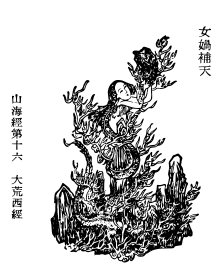Nüwa Mends the Heavens
Nüwa Mends the Heavens (Chinese: 女娲補天; pinyin: Nǚwā bǔtiān) is a well-known theme in Chinese culture. The courage and wisdom of Nüwa inspired the ancient Chinese to control nature's elements and has become a favorite subject of Chinese poets, painters, and sculptors,[1] along with so many poetry and arts like novels, films, paintings, and sculptures; e.g. the sculpture that decorate Nanshan[2] and Ya'an.[3]

Nuwa the human creator
The Huainanzi tells an ancient story about how the four pillars that support the sky crumbled inexplicably. Other sources have tried to explain the cause, i.e. the battle between Gong Gong and Zhuanxu or Zhu Rong. Unable to accept his defeat, Gong Gong deliberately banged his head onto Mount Buzhou (不周山) which was one of the four pillars. Half of the sky fell which created a gaping hole and the earth itself was cracked; the earth's axis mundi was tilted into the southeast while the sky rose into the northwest. This is said to be the reason why the western region of China is higher than the eastern and that most of its rivers flow towards the southeast. This same explanation is applied to the sun, moon, and stars which moved into the northwest. A wildfire burnt the forests and led the wild animals to run amok and attack the innocent peoples, while the water which was coming out from the earth's crack didn't seem to be slowing down.[4]
Nüwa pitied the humans she had made and attempted to repair the sky. She gathered five colored-stones (red, yellow, blue, black, and white) from the riverbed, melted them and used them to patch up the sky: since then the sky (clouds) have been colorful. She then killed a giant turtle (or tortoise), some version named the tortoise as Ao, cut off the four legs of the creature to use as new pillars to support the sky. But Nüwa didn't do it perfectly because the unequal length of the legs made the sky tilt. After the job was done, drove away the wild animals, extinguished the fire, and controlled the flood with a huge amount of ashes from the burning reeds. The world became as peaceful as it was before.[4][5]
Empress Nuwa
Many Chinese know well their Three Sovereigns and Five Emperors, i.e. the early leaders of humanity as well as culture heroes according to the Northern Chinese belief. But the lists vary and depend on the sources used.[6] One version includes Nüwa as one of the Three Sovereigns, who reigned after Fuxi and before Shennong.[7]
In her matriarchal reign, she battled against a neighboring tribal chief, defeated him, and took him to the peak of a mountain. Defeated by a woman, the chief felt ashamed to be alive and banged his head on the heavenly bamboo to kill himself and for revenge. His act tore a hole in the sky and made a flood hit the whole world. The flood killed all people except Nüwa and her army which was protected by her divinity. After that, Nüwa patched the sky with five colored-stones until the flood receded.[8]
Culture
- Dream of the Red Chamber (1754) narrates how Nuwa gathered 36, 501 stones to patch the sky but left one unused. The unused stone plays an important role in the novel's storyline.[9]
- Goddess Nüwa statue named "Sky Patching" by Prof. Yuan Xikun was exhibited at Times Square, New York City, on 19 April 2012 to celebrate Earth Day (2012), symbolized the importance to protect ozone layer.[10] Previously, this 3.9 meters statue was exhibited on Beijing and now is placed on Vienna International Centre, Vienna since 21 November 2012.[11]
- "Goddess Nuwa patches up the sky" (2013) is an application for iPhone and iPad by Zero Studio.[12]
- The story of Nuwa patching the sky was being retold by "Carol Chen" on her book "Goddess Nuwa Patches Up the Sky" (2014) which was illustrated by "Meng Xianlong".[13]
- The movie Xīyóujìzhī Dànào Tiāngōng (西游記之大鬧天宮) ("Journey to the West - The Monkey created chaos in heaven") (2014) directed by "Soi Cheang Pou-soi" shows the battle between Jade Emperor (Chow Yun Fat) and Bull Demon King (Aaron Kwok). Nuwa (Zhang Zilin) sacrifice herself to repairs the heaven and make a heavenly gate to protect the heaven from invading demons.[14]
References
- "NUWA REPAIRS THE HEAVENS (Nuwa Bu Tian)". Beijing: China on Your Mind. 2013. Retrieved 15 November 2015.
- dartman. "Goddess Nu Wa Patching the Sky". Panoramio. Retrieved 15 November 2015.CS1 maint: uses authors parameter (link)
- Zhitao Li. "Nuwa Patching the Sky". Dreamstime. Retrieved 15 November 2015.CS1 maint: uses authors parameter (link)
- anonim (26 October 2009). "The Nuwa Sacrificial Ceremonies". Beijing: Confucius Institute Online. Retrieved 15 November 2015.CS1 maint: uses authors parameter (link)
- Skryrock. "Nüwa Repairs the Heavens". Chinese Geography. Retrieved 15 November 2015.CS1 maint: uses authors parameter (link)
- Hucker, Charles (1995). China's Imperial Past: An Introduction to Chinese History and Culture. Stanford University Press. p. 22. ISBN 9780804723534.
- 劉煒/著. (2002) Chinese civilization in a new light. Commercial press publishing. ISBN 962-07-5314-3, p. 142.
- Mark Isaak (2 September 2002). "Flood Stories from Around the World". Retrieved 15 November 2015.CS1 maint: uses authors parameter (link)
- Lianhua Andy (25 September 2015). "Penciptaan Bumi & Manusia Menurut Chiness Mitologi (Pangu ,Nuwa & Fuxi)" (in Indonesian). Retrieved 15 November 2015.CS1 maint: uses authors parameter (link)
- "Unveiling Goddess Nüwa in NY Times Square and Beijing". United Nations Environment Programme (UNEP). 22 April 2012. Retrieved 15 November 2015.
- "Ozone statue unveiled in Vienna to mark Montreal Protocol anniversary". UNIDO. 22 November 2012. Retrieved 15 November 2015.
- "Goddess Nuwa patches up the sky". Zero Studio. 2013. Retrieved 15 November 2015.
- anonim (2014). "Goddess Nuwa Patches Up the Sky - the Chinese Library Series (Paperback)". AbeBooks Inc. Retrieved 15 November 2015.CS1 maint: uses authors parameter (link)
- Jedd Jong (4 February 2014). "The Monkey King". Retrieved 15 November 2015.CS1 maint: uses authors parameter (link)